Home
Repair And Restoration
Gear Lever Shim Bodge
Bodge Date - 04 February 2017
By Ren Withnell
Previously on Bikes And Travels...Gear Linkage Bodge
In the comments of that page I foolishly suggested the links of the gear linkage did still have some play in them but the worst part of the whole gear shift mechanism was the slack or play where the lever meets the footrest hangar. While this rarely causes me any trouble Sharon's Keeway 125 also has a lot of slack and that does bother her.
Of course some wise ass (Ian Soady) suggests I just get some shim steel in some ancient medieval measurement of - ahem - "thousands of an inch" and shim out the slack in/on the pivot point. OK. Admittedly I had envisioned grinding out the pivot point centre that is part of the footrest hangar. I would then source some suitably sized steel bar which I would thread and tap into the footrest hanger and everything would be as perfect as a summer's day in a romantic movie. I, well, I, perhaps well, no, I hadn't thought of just wedging a bit of skinny metal in there.
Ebay has for sale "shim steel". Luckily it comes in thicknesses I understand as in 0.25mm and 0.5mm thickness. There is also "hard", "half hard" and presumably "soft" although I didn't see any "soft". I had to check but the logic is obvious. Hard is...hard but of course a little brittle. Half hard is - go on - you guess. That's right it's not as hard but it's not dead soft it's kinda half hard really. I know I've got to bend this stuff so I opt for half hard. My pivot point is perhaps 22mm wide but shim steel, at least on ebay, only comes in 15.5mm wide or less so I order 15.5mm wide, 1 metre long and 0.5mm thick.
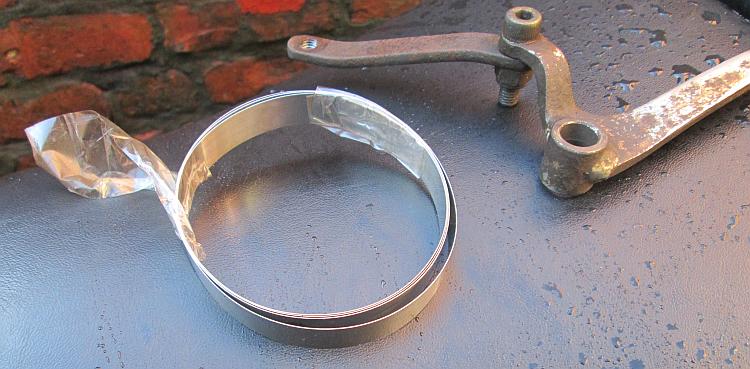 A roll of "Shim Steel" and the lever ready to be engineered (aka bodged)
A roll of "Shim Steel" and the lever ready to be engineered (aka bodged)
Cutting shim steel isn't easy. The hacksaw just grabs it, pliers and snips barely touch it and bending it to and fro to snap it seems all wrong. I find using a file is the most effective method strangely enough. Curling it into a tube is manageable with pliers and an old bolt. I make one single tube but it is far far too thick for my purposes. Should I have opted for 0.25mm thick?
Naaaaaaah. Using the bench grinder I slowly nibble away at the tube making it 7/8ths of a tube, still too big. 3/4 of a tube, still just a little too tight. 5/8 of a tube? Now we're almost there. Just a little nibble more off and we're away.
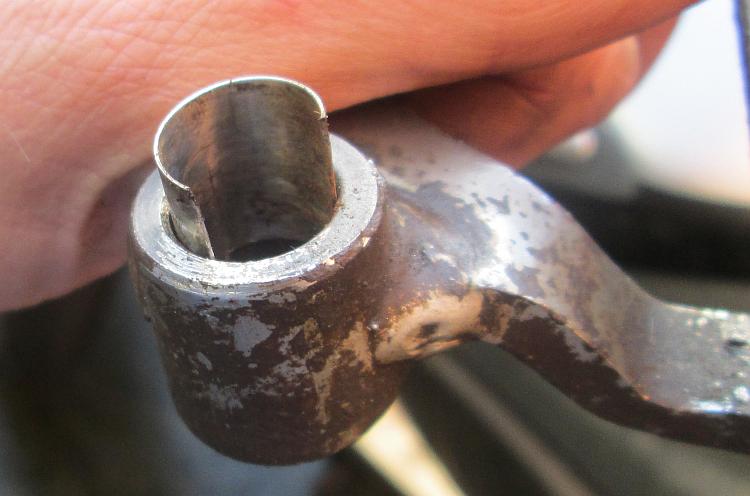 There, that's about right now. I'll stick it back on the bike.
There, that's about right now. I'll stick it back on the bike.
To keep Ian Soady from moaning and to prove that grease in this pivot point is pointless as it will get filled with road grit...I thoroughly and completely fill the whole shebang with grease, tighten everything up and check for operation. Operation is good. All that's left to do now is ride the thing but I really can't be bothered right now. Anyhow as soon as Sharon reads this she will be DEMANDING that I apply the same operation to her Keeway RKS125. I shall let her report on the success or indeed failure of Ian's suggestion and my attempt to implement it.
Reader's Comments
Ian Soady said :-
Pleased to be of help.....
Of course the advantage of this approach is that when it wears a bit more (which of course it won't now you've greased it) you have stacks of material to make new bearing surfaces.
I wouldn't use this technique on safety critical items (although have done so on footbrake lever pivots as these are always well worn on old Brit bikes, previous owners having ignored the grease nipples which most manufacturers kindly provided).
05/02/2017 10:42:27 UTC
Ren - The Ed said :-
One good thing about having this 'ere website is it's great record of what jobs I've done on the bike and when. I will one day notice the gear lever is floppy once again and wonder how long it lasted. I shall be able to call this page up to make an analysis.
The lever was never a snug fit from day one. I might be permitted to say with the shim in it is probably better than new in fact. I can't see any reason the shim and the remaining pivot shouldn't stay in good order for another 10,000 miles at least and I wouldn't be surprised if it lasted a lot longer.
It'll probably outlive the bike, it is getting on a little now. Perhaps my CBF125 could be your next restoration project after the Sunbeam is sold? At least you can still get parts for the Honda.
05/02/2017 17:48:41 UTC
Ian Soady said :-
Thanks for the kind offer....
But I've decided (against much well-intentioned advice) that I really fancy an Ariel Arrow. Preferably a Golden Sports model as below:
Have now stripped the primary drive and as I expected I had fitted the split pin so now all buttoned up ready for another test start.
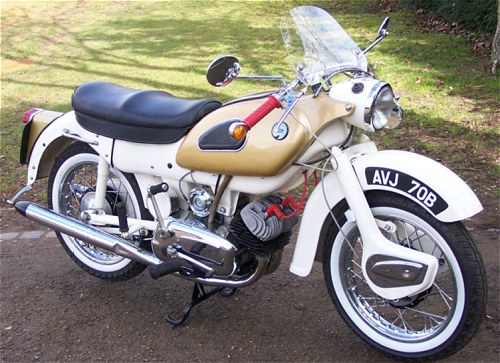 06/02/2017 10:20:24 UTC
06/02/2017 10:20:24 UTC
Ren - The Ed said :-
2 stroke! That's cheating, that's far too easy, that'll be like taking candy from a baby. I suppose the pressed steel chassis ought to be nicely rusted so that could be a challenge.
I must say while it's not my project the bike is not to my liking.
06/02/2017 13:39:47 UTC
Ian Soady said :-
Yes, I've always hated them, starting my riding career on a 150cc Francis Barnett. I've also had a Bantam and 2 MZs (can't understand what possessed me to buy the second one).
But I've always liked the look of the Arrow and of course 2 strokes have interesting features like crankcase seals to baffle me. The Arrow / Leader is also quite strange by all accounts so look forward to a new challenge.
And.....
The Sunbeam started first kick and ran very nicely (with a bit of tappet rattle as they settled down). I videoed it but can't at this moment remember how to convert mp4 for youtube but when I do will post a link so you can gasp in astonishment.
06/02/2017 13:49:31 UTC
Ian Soady said :-
running (clattery as the tappets have settled).
youtu.be/Zp5ER9fLjZw...
06/02/2017 14:38:09 UTC
Ren - The Ed said :-
I have to admit it is rather splendid to see the Sunbeam in operation. With the single cylinder and exposed parts it is very tangible and real, like a steam engine or bicycle.
Far more satisfying than an 'orrible 2 stroke.
06/02/2017 21:37:36 UTC
Ian Soady said :-
I find the gear lever position on the Honda very cramped for my size 47s.
So I have made a short extension using about £.50 worth of 5mm x 12mm steel and a £2.50 rose joint (plus a surplus gear lever from a kind person on the Grey 400 forum).
Components:
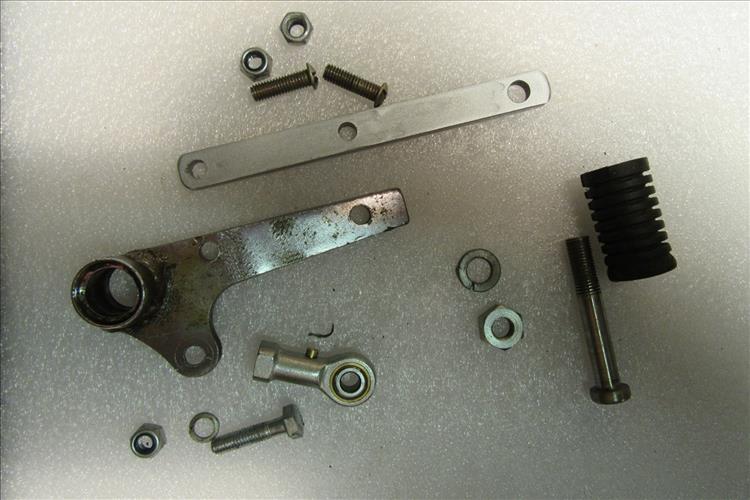 11/02/2017 12:02:15 UTC
11/02/2017 12:02:15 UTC
Ian Soady said :-
Assembled:
(spot the 5/16" BSCy threads....)
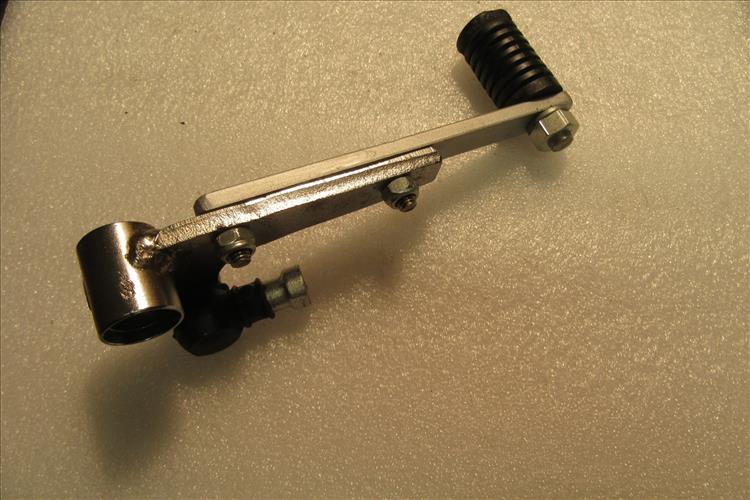 11/02/2017 12:02:54 UTC
11/02/2017 12:02:54 UTC
Ren - The Ed said :-
Continuing from your chit chat...
You've used an imperial thread on a metric motorcycle!! Tell me are the nuts and bolts also imperial? You'll be confusing any future owners, they'll not know whether they're coming or going.
11/02/2017 17:10:28 UTC
Borsuk said :-
My ambition at work was always to go to the ships cargo manifolds and remove all the bolts from the 4 manifolds (about 116 bolts approx 38mm) using only 2 proper closed ring spanners, no shifters or stilsons, one for the bolt and one for the nut. Sadly this has never came to pass. Every tanker I have been on requires at least 4 different metric spanners, at least one shifter and on occasions a stilson. The creme de la creme is when you are on a ship built after 2000 in a far eastern yard and somehow, someone has found a British Standard Whitworth bolt somewhere and mated it with a metric nut. That's when the hacksaw's come out.
11/02/2017 18:07:21 UTC
Ian Soady said :-
"You've used an imperial thread on a metric motorcycle!!"
Yes but only for the toepiece as it's a bit of a pain cutting metric threads in the lathe and I don't have metric taps & dies (except for some autojumble specials which are worse than useless and I should chuck them away).
Everything else is proper 8mm.......
12/02/2017 10:26:42 UTC
Ian Soady said :-
"8mm" read 6mm.
And of course this mod will only be on the bike whilst it is in my ownership and will be replaced by the original item when it eventually moves on (although will of course be offered to any new owner).
12/02/2017 13:49:15 UTC
Ren - The Ed said :-
Borsuk it is hard for us mere mortals to imagine a manifold with 116 bolts let alone to then consider that they may all be random sizes. I guess at least on a ship engine if you drop a 38mm nut it's unlikely to slip between the flagging on the engine room floor.
As for your imperial adaptations Mr Soady, while you may be able to restore the CB400 Super Four to original I shall be having nightmares now about British Standard Whitworth an Across Flats. What's the difference between BSW and AF anyhoo?
12/02/2017 22:13:31 UTC
Ian Soady said :-
"What's the difference between BSW and AF anyhoo? "
Lots and lots.....
Although AF actually stands for Across Flats and isn't a thread system as such (although some people think it stands for American Fine). If you think about it, all metric spanners are measured across the flats. Whereas all nut / bolt sizes are correctly denoted by the diameter of the thread. Like 6mm for the bolts on my gear lever extension.
So here we go.
British Standard Whitworth and Fine (BSW and BSF) are all 55 degree threads originally devised by Mr Joseph Whitworth in the 19th century. He came to the thread angle by averaging out the different angles of existing threads he examined. There were previously no standards at all anywhere in the world.
His Whitworth thread (later to be formalised as BSW) was a relatively coarse pitch and was suitable for the machinery of the time. Later, BSF (still using the 55 degree angle) was developed for smaller parts which needed finer threads and greater clamping force, as well as having better materials. BSW was still used for threads into aluminium and other softer material. BSW/F are measured in imperial units. The spanner sizes are denoted by the bolt diameter NOT the head size; BSF head sizes are normally one size smaller than the corresponding BSW size - notionally to minimise people putting excess pressure on the spanner and stripping the thread. Spanner sizes are not interchangeable with UNF / UNC.
Cycle (BSCy) was developed by the bicycle industry when it was called CEI and is actually still used there. It has a 60 degree thread angle and in most smaller sizes a consistent 26 tpi pitch (although there are many variations). Spanner sizes are the same as BSF/ BSW
UNF and UNC (Unified National Fine and Coarse) are originally American in origin. They use a 60 degree thread angle. UNF is generally a finer pitch than either Cycle or BSF for the same diameter. The spanners for these are marked with the head size hence A/F.
You probably know about metric, most of which conform to the ISO (International Standards Organisation) standard although some earlier Japanese bikes had their own "standards". Bolts / nuts are defined by diameter; spanner sizes across flats as mentioned. Pitches are described by the distance between adjacent peaks (eg 1mm) rather than the number of threads for a unit of length as British / American threads are.
Then of course we have a plethora of other forms - BSP parallel and taper; Thury watchmakers threads; BA (British Association) used for small electrical components etc etc. All have their quirks - eg BSP (British Standard Pipe) are denoted by the nominal pipe size rather than the actual thread diameter so 1/4" BSP is around 1/2" thread diameter.
Pre-war British vehicles used mostly BSW / BSF / Cycle (although spark plugs have always been metric form). Around the 1960s there was a move to UNF / UNC and many vehicles at the time had an odd mixture of the two - my Norton Commando being one. Then in the 1980s the move to metric was started so my 2001 Land Rover has (almost) exclusively metric fasteners.
There you are: I expect you wish you'd never asked. For anyone still awake, I recommend Machinery's Screw Thread book which is a compendium of everything you could possibly want to know about threads.
13/02/2017 10:32:13 UTC
Ren - The Ed said :-
And people seem to think things were better in the good old days. It's times like these I'm glad I'm a child of the '70s. No pounds shillings and pence, just pounds and pence. I do still weigh myself in "stones" but I'm now comfortable with kilograms. If my nut is "12mm" I know the spanner will need a 12mm gap. I am still however 5 feet 8 inches tall. ARGH!
I'm aware of different pitches and can logically see how finer threads produce more clamping force for a given torque, I also know finer threads can be stripped more easily. I never consider pitch though, basically if the nut goes on the bolt then job's a good 'un.
13/02/2017 11:25:18 UTC
Ian Soady said :-
You should however remember that there are different pitches in the metric system - most often 1mm but you often find .75mm and 1.25mm as well.
The most egregious example of mixtures I have come across (at least perpetrated by a manufacturer) was the cylinder head and barrel fixings on the Commando. There was a stud protruding down from the rear of the head, through a flange on the barrel which was masked by the carbs. It was 5/16" Cycle (26 tpi). There were more nuts on the barrel base which were 5/16" UNF (28 tpi).
28 and 26 tpi are just close enough to let you get one of the base nuts started on the head stud. As it was almost impossible to get your fingers in there, and you needed a specially modified spanner, it was very easy to get it started and wound up till it became painfully obvious it was the wrong one - at which point the thread on the stud was wrecked.
What larks!
13/02/2017 12:47:35 UTC
Ren - The Ed said :-
I gotta admit doing the shims on the 500 has been an absolute and total nightmare of wires, tubes, clips, nuts, bolts, plastics, widgets and tight spaces.
However...no real confusion over bolts at least.
13/02/2017 13:55:19 UTC
Ted said :-
Metric V Imperial?
I reckon there must be as many engineering tales to tell as there are screw threads.
I still have a set (proper set) of AF sockets which NEARLY FIT some metric bolt heads.
It was enough with the 2 Ronnies "FORK HANDLES" sketch,
But
When you go to a hardware store to buy a 75 foot garden hose and get
told..."it is sold in metres now".
DUH, so how long is there meter fings?
Oh, just over 3 feet (39.375" )
Right.....then I'll have 25 of those metre things please.
What diameter would you like sir.....
1/2" or 3/4" ?
With regards 2 stokes, one of the nicest I rode (at the time) belonged my guvnor.
I had a throttle cable break on my bike on the way to work on a Friday.
We were snowed under and I had already worked 2 hours over time every night of the week previously.
I told him I wouldn't be working this Friday night as I had to limp the bike home on a fast idle and Saturday morning I would be replacing the throttle cable...
UNLESS, of course he wanted to lend me HIS bike to get home on that evening.
Flash sod had a nice newish BMW and this Suzuki 380GT.....only about 6 months old.
I was really looking forward to an early finish....
He left till about 15 minutes before I was due to leave that afternoon and then a set of keys came sliding across my work bench.
"Get your missus to get you a new cable, you can fix it tomorrow afternoon WHEN you get home after doing overtime.
Scratch my bike and you'll find out what a P45 is !
That was the fastest I had ever got along the Old Kent road in the evening AND equally as fast getting to work the Saturday morning.
Wife number one (not that I ever introduced her as that ;-) duly drove down and got my new cable and I limped my own bike home after work that Saturday morn and was really (NOT) looking forward to spending another hour on my hands and knees fitting the new cable.
I have hankered after a 380GT to this day.
Never could afford one then.....
Check out EBAY prices now!!
That ain't like a "modern" bike but just as blooming expensive!
Nostalgia....oh mate, why can't fings be like they used to be?
28/07/2017 17:51:02 UTC
Ted said :-
Oh Ren, do you know why the UK went over to this "Metric Money?"
I don't remember "groats" (Not quite that old.)
But we used to have 4 x farthings in an old Penny.
2x half Pennies in an Old Penny.
3x Old Pennies in a three penny piece(similar shape to the new £1.0 coin)
Allegedly the old 3d coin was designed by an East London tailor,
So he could get them out of a customers hand with a spanner.
I DIGRESS....I'm good a that.
6 x Old Pennies in a (wait for it) six pence coin.
12 x old Pennies in a Shilling
2 x Shillings in a Florin
2 Shillings and Six pence in a "Half Crown"
Obviously 5 shillings in a Crown.
20 shillings in a pound note...yep, pounds notes...
Oh, and the 10 bob note.....1/2 a"bar"....10 shillings in a brown coloured note.
You just don't know what you missed NOT being at school in the
"good old days"
We even had to learn our times table lol.
Soooo, why did we go over to "Metric Money?"
Darn frogs only have the same amount of fingers as us, but never learned to count any higher than 10 !!!!
BREXIT?
Bring it on, Please can I have my country back before it's too late
28/07/2017 18:00:15 UTC
Ren - The Ed said :-
Being born in 1971 I was raised metric and I am used to it. Except I'm 5 feet 8 inches tall and weigh 12 and a half stone. Any my yard is 14 feet long. Dammit!
As for two strokes. The first 2 motorcycles I owned were a Honda H100A and a H100SII. They got me going and got me through my test. But urgh, I have absolutely zero desire to own one. The first "big" bike I rode was a RD350 YPVS. I hear endless tales about how absolutely wonderfully brilliantly excellent they were. Erm. Nope.
My first 4 stroke bike was a Honda CD200 Benly. Now THAT...THAT was a proper, real, brilliant bike. 50,000 miles and I didn't have to rebore it, take the head off and decoke it and throw an endless supply of rings, barrels, bearings and 2 stroke at it.
29/07/2017 10:42:10 UTC
Matt Mac said :-
Hi,I have read through the most off your site , what a fantastic job you guys are doing . I had an Ariel leader and an arrow it was great to see the photo of one again . I have an Ariel 1943 w/Ng in hundred pieces , bought for £200 .It is pretty much all there c/w new petrol tank . Ps thought it would make a good ww2 photo with Sharon cleaning it ( French maid) .It would be to dear her fee ferry to n Ireland hotel and off course divorce settlement when my wife saw Sharon and you
03/09/2017 11:44:55 UTC
Ian Soady said :-
Hi Matt.
You probably already know this but the AOMCC forum has a special section for W/NGs. You don't have to join the club to access the forum.
forum.arielownersmcc.co.uk/index.php?sid=7f6ae8f94ea43c61246eca8d0c03b805...
04/09/2017 08:38:38 UTC
K_C_M said :-
HI Ren & the rest of the world! I recently bought a CBF125 and the gear lever has huge amounts of slack that make it difficult to select gears.
I already have a selector that is in better condition, but the pivot on the frame is badly worn as are the link joints on the rest of the linkage. I want to replace the whole affair with rose type joints and shim the pivot as described above.
I have been searching for the shim steel in a an appropriate width but only find 1/2 inch or less. Can you provide the name of a supplier for this or a link to the seller that you purchased from?
26/11/2019 13:42:41 UTC
Ian Soady said :-
I take it you haven't read Zen and the art of motorcycle maintenance. Shim steel is available in abundance. It comes wrapped round baked beans and the like and all you need is a pair of tinsnips - or probably for Ren his nail scissors.
If you want softer alloy shim it comes holding beer and soft drinks......
26/11/2019 14:41:59 UTC
Ren - The Ed¹ said :-
I used Ebay, searched for "shim steel". I must admit a cursory look just now does not come up with much of suitable width. Other than that I don't have a direct link for you. As Ian said don't go overboard with costly shim material. I'd be cutting up that which I can find with a Dremel and trying that.
I do strongly recommend replacing the connectors with rose joints. Since doing this I no longer need to shim the pivot. Check out the link
https://bikesandtravels.com/biker.aspx?ride=1049...
26/11/2019 16:02:54 UTC
Name
Comment
Add a RELEVANT link (not required)
Upload an image (not required) -
Uploading...
Home
Repair And Restoration